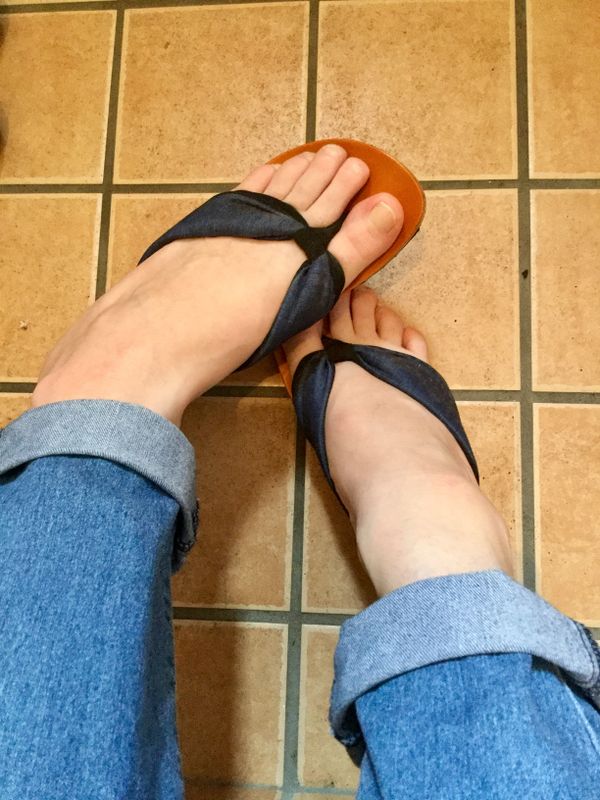Aug 31, 2019
Traditional Footwear, Health and Comfort
Japan causes me a lot of footwear grief. With wide and long feet, it’s hard for me to find footwear that is both attractive and functional. And yet another issue is cost. Good footwear that fits tends to be expensive.
I’ve learned a lot about footwear in Japan as I’ve researched footwear choices that protect my health.
Uwabaki
At nearly every school, private or public, students and teachers wear上履き uwabaki, indoor shoes. The first kanji for it is a reminder of the Japanese indoor-outdoor distinction. Upper is inside, clean and safe, while outside is dirty and possibly perilous. The school I work at requires students to wear running shoes. Dirt and wet stay outside, and the soft soles of running shoes mean the kids walk silently. However, they do holler and carry on, so what little calm we get from quiet footwear is negated by rowdiness.
 I tend to favor Crocs, as do many of my colleagues. Models like the ones I wear come in larger sizes. And they meet the safety standard - closed toe and covered heel. In an emergency, you need shoes you can slip into in a flash, and ones that you won’t get easily pulled off in a chaotic situation. Some teachers wear running shoes, sandals with good coverage, and even ankle height tabi boots.
I tend to favor Crocs, as do many of my colleagues. Models like the ones I wear come in larger sizes. And they meet the safety standard - closed toe and covered heel. In an emergency, you need shoes you can slip into in a flash, and ones that you won’t get easily pulled off in a chaotic situation. Some teachers wear running shoes, sandals with good coverage, and even ankle height tabi boots.
Five toe socks and tabi

Tabi socks, traditional Japanese footwear, allow your big toes freedom of movement and allow your feet to breathe. In the traditional Japanese martial art that I train in, practitioners usually wear cotton tabi with either reinforced cotton or suede soles. Like any athletic activity where many feet meet the same surface, there is the risk of transmission of fungal and bacterial infections. Wearing tabi protects toes and prevents transmission of bugs.
A habit from my martial training is 柔軟体操, junan taiso, or body conditioning. Joints, muscles, and tendons get worked to keep the practitioner limber, and it starts with the feet. Wearing tabi makes it easier to work on the big toes, soles, and ankles through massage and stretching.
For dojo wear, my favorite kind of tabi are leather with “magic tape” closures. My feet are always fresh feeling, and I don’t notice the heat or cold. I don’t wash the leather versions. On laundry days, I simply turn them inside out and put them in full sun which kills germs and makes them smell fresh.
Whether I am wearing shoes or geta, I often put on cotton tabi socks or five toe socks. Tabi socks isolate the big toe for wearing geta, but five toe socks free them all. While five toe socks may have been inspired by tabi, they were first popularized in the 1970s in the US, and in Japan, many sock shops stock them. Besides freedom of movement, the cotton isolates your toes, keeping your feet dry and fresh. I never suffer foot odor when I wear them.
Geta and Zori
When it comes to traditional footwear, there are some interesting health claims. One of the common ones is that the strap passing between the big and second toe stimulates a pressure point, relaxing the feet. According to research, geta can be worn to improve gait. When you swing your feet and land, your toes make full contact with the foot bed.
While I’ve never worn traditional ladies geta that go with kimono, I’ve taken to wearing a modern version which comes in larger sizes, and they’re fashionable. The kind I wear, Mizutori, have a slight heel, and the foot beds are shaped to accommodate your sole. The makers claim that wearing geta increases even toe pressure, improving posture.
 What I’ve noticed is my toes are relaxed, I walk with a straighter posture, and my feet don’t get fatigued like they do in flat shoes. They look, cool, too. People sometimes remark on them when I’m on the train or out shopping. That makes me feel good!
What I’ve noticed is my toes are relaxed, I walk with a straighter posture, and my feet don’t get fatigued like they do in flat shoes. They look, cool, too. People sometimes remark on them when I’m on the train or out shopping. That makes me feel good!



0 Comments